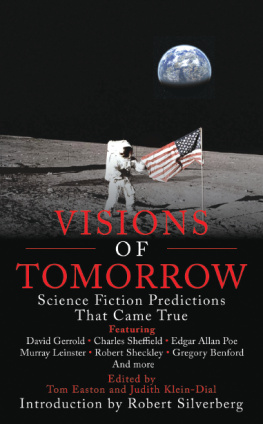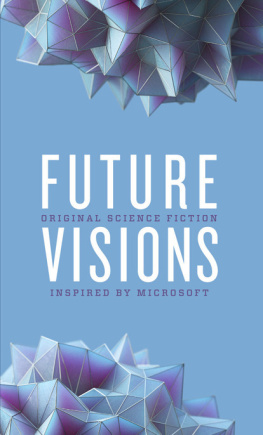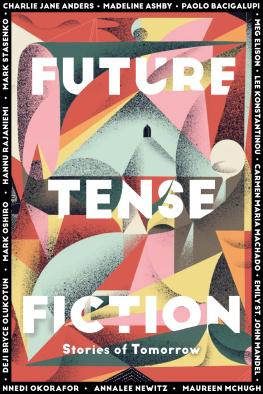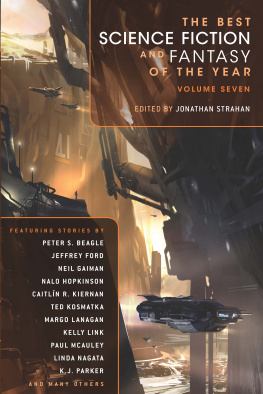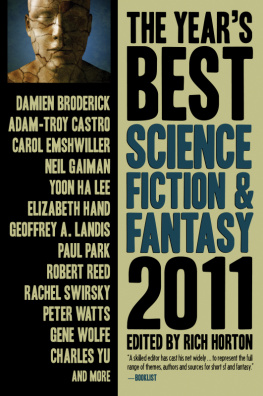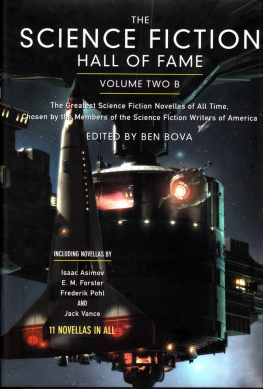VISIONS
OF
TOMORROW
VISIONS
OF
TOMORROW
Science Fiction Predictions
That Came True
EDITED BY
THOMAS A. EASTON
AND
JUDITH K. DIAL

Copyright 2010 by Thomas A. Easton, Judith K. Dial, and Tekno Books.
All Rights Reserved. No part of this book may be reproduced in any manner without the express written consent of the publisher, except in the case of brief excerpts in critical reviews or articles. All inquiries should be addressed to Skyhorse Publishing, 555 Eighth Avenue, Suite 903, New York, NY 10018.
Skyhorse Publishing books may be purchased in bulk at special discounts for sales promotion, corporate gifts, fund-raising, or educational purposes. Special editions can also be created to specifications. For details, contact the Special Sales Department, Skyhorse Publishing, 555 Eighth Avenue, Suite 903, New York, NY 10018 or info@skyhorsepublishing.com.
www.skyhorsepublishing.com
10 9 8 7 6 5 4 3 2 1
Library of Congress Cataloging-in-Publication Data available on file.
ISBN: 978-1-60239-998-3
Printed in Canada
C ONTENTS

(Predictions that have already happened)
(Transatlantic flight; dirigibles)
(Armored tanks)
(Atomic bomb)
(Reality TV)
(Prototypes have been built)
(Laser mosquito zapper)
(Chip-controlled animals)
(Computer-related predictions)
(Internet)
(Computer viruses)
(Internet addiction)
(Identity theft)
(Biological predictions)
(Biological virus engineering)
(3D printing of living things)
(Gene-doping)
(Predictions of things to come)
(Human genomes on file used for growing replacement parts)
(Space elevator)
C OPYRIGHTS

I ntroduction 2010 by Robert Silverberg. Preface 2010 by Thomas A. Easton and Judith K. Dial.
Deadline by Cleve Cartmill. Copyright 1944 by Street & Smith Publications, Inc., copyright renewed 1972 by Cond Nast Publications, Inc. First published in Astounding Science Fiction, March 1944. Reprinted by permission of the heir to the authors Estate, Matt Cartmill.
The Prize of Peril by Robert Sheckley. Copyright 1958 by Robert Sheckley. First published in The Magazine of Fantasy & Science Fiction, May 1958. Reprinted by permission of the Executor of the authors Estate, Gail Dana Sheckley.
Directed Energy by Jeff Hecht. Copyright 2006 by Jeff Hecht. First published in Nature, April 2006. Reprinted by permission of the author.
Matchmaker by Thomas A. Easton. Copyright 1990 by Thomas A. Easton. First published in Analog Science Fiction and Fact, August 1990. Reprinted by permission of the author.
A Logic Named Joe by Murray Leinster. Copyright 1946, 1974 by the heirs of the Literary Estate of Will F. Jenkins, a.k.a. Murray Leinster. First published in Astounding Science Fiction, March 1946. Reprinted by permission of the Estate and the Estates Agents, the Virginia Kidd Agency, Inc.
The Scarred Man by Gregory Benford. Copyright 1970 by Gregory Benford. First published in Venture, May 1970. Reprinted by permission of the author.
The Infodict by James Van Pelt. Copyright 2001 by James Van Pelt, First published in Isaac Asimovs Science Fiction Magazine, August 2001. Reprinted by permission of the author.
E-Mage by Rajnar Vajra. Copyright 1999 by Rajnar Vajra. First published in Analog Science Fiction and Fact, July/August 1999. Reprinted by permission of the author.
How We Saved the Human Race by David Gerrold. Copyright 1972 by David Gerrold. First published in With a Finger in My I. Reprinted by permission of the author.
Misprint by Vonda N. McIntyre. Copyright 2008 by Vonda N. McIntyre. First published in Nature, July 2008. Reprinted by permission of the author.
Excellence by Richard A. Lovett. Copyright 2009 by Richard A. Lovett. First published in Running Times, May 2009 (revised from a previous version published in Analog Science Fiction and Fact, January/February 2009). Reprinted by permission of the author. All rights reserved.
The Mechanic by Hal Clement. Copyright 1966 by Harry Clement Stubbs. First published in Analog Science Fiction and Fact, September 1966. Reprinted by permission of the Executor of the authors Estate, Mary Stubbs.
Skystalk by Charles Sheffield. Copyright 1979 by Charles Sheffield. First published in Destinies, August/September 1979. Reprinted by permission of the Executor of the authors Estate, Nancy Kress.
S CIENCE F ICTION AS P ROPHECY

Robert Silverberg
T heres a widespread impression among people who dont read science fiction that science fiction writers are capable of predicting the future. They believe that television, computers, spaceships, atomic bombs, and space satellites all were described in science fiction stories long before they became realities, and that anyone who wants to know whats coming next in our troubled world needs only to keep up with the current sf literature.
I will concede that thats true in a very general way. But in fact science-fiction writers dont regard themselves as prophets by tradeI can testify to that, after close to sixty years in the businessand the actual record of science fiction as prophecy shows a few brilliant guesses, some impressive almost-on-the-mark predictions, and a vast number of predicted futures that never came aboutindeed, have been shown by time to have been completely wrongheaded. Most of us are just telling stories, after all. We look at the world about us and try to extrapolate current trends into future developments, and, because we know the tricks of the trade, we are often able to come up with some very interesting speculations that now and then turn out to be surprisingly accurate anticipations of things to come. Some of them, though, are just speculationsinteresting enough for the purposes of the story, but not in any way an accurate forecast of the future. And even those science-fictionists who devote serious effort to forecasting the future are immensely better at forecasting general patterns than at discerning specific details. It isnt really difficult to extend broad technological or social trends into the future, but making sharp and specific predictions is more a matter of luck than genius, even for the best of science-fiction writers.
I can demonstrate that by showing you how two of the best writers who ever wrote science fiction went astray in their attempts to give us a view of the very short-term future.
Robert A. Heinlein was one. Heinlein, an Annapolis graduate with a strong grounding in the sciences, took an engineers approach to the future. Everything he wrote was developed rigorously out of a broad and deep knowledge of our own world, forming a coherent and internally consistent vision of times to come.
In 1949 a Hollywood producer asked Heinlein to do the screenplay of a documentary-style movie about the first voyage to the moon, and to serve as the films technical adviser. The result was Destination Moon (1950). It was thoughtfully done down to the smallest touches. Cunning special effects provided authentic reproductions of a rocket launching, of the gravitational effects of acceleration, of a spacewalk, of the lunar surface.

